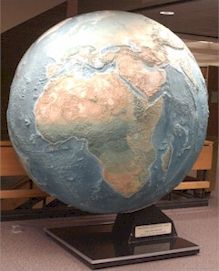Carlson Library's Globe
 The Carlson Library globe, formerly next to the stairway on the first floor, now on
the third floor, is often a source of questions from library visitors. The table
below summarizes some data about the globe, followed by an article from The Alumnus on the history and features of the globe.
The Carlson Library globe, formerly next to the stairway on the first floor, now on
the third floor, is often a source of questions from library visitors. The table
below summarizes some data about the globe, followed by an article from The Alumnus on the history and features of the globe.
| Dimensions & Specifications of the Globe | |
| Diameter (at Sea Level) |
75 inches |
| Overall Height | 90 inches |
| Scale | 1:6,700,000 (1 inch = 106 miles) |
| Vertical Scale | Approximately 40x the horizontal |
| Mt. Everest | 3/4 inch |
| Construction | Hand laminated in Fiberglass and epoxy |
| Motor | 1/4 horsepower, 4 amp., 110 volt, AC 40-70 cycles |
| Rotation | 1/3 RPMs |
| Weight | Each hemisphere, ~160 lbs. Base, with motor and axis, 210 lbs. |
| The globe is cast in two hemispheres which fit precisely at the equator. It is shipped
in three cases, one for each hemisphere, one for the base. The unit is completely
free standing, can be installed in a few hours, and can be dismantled and relocated
as desired.
The base lies entirely within the perimeter of the globe, so the maximum space required for the globe is an area 77 inches in diameter |
|


